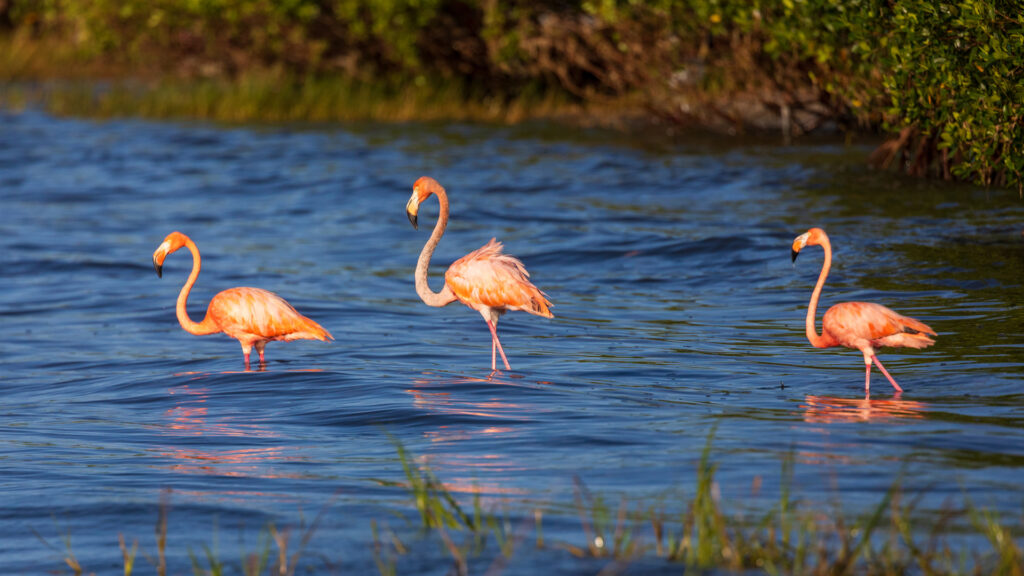By Ruscena Wiederholt and Steven Whitfield, Florida Flamingos Working Group
It’s that time of year again — the race is on for Florida’s state bird.
The battle to dethrone the current northern mockingbird with the Florida scrub jay has been going on for decades, but this time a rosy new candidate is in the ring: flamingos. American flamingos, largely sidelined in this match, are an official candidate as of early December.
The timing couldn’t be better as dozens of flamingos now crisscross the state — adding a splash of color to mudflats, inland lakes and lagoons. After Hurricane Idalia, sightings of these blushing beauties poured in from across the state.
Flamingos are normally found throughout the Caribbean, the Yucatan peninsula and northern South America. However, birds can be blown hundreds of miles off course by storms, a boon for bird watchers anticipating an exotic batch of species. Normally, after the dust settles, these avian visitors return home. Yet, since Idalia in late August, dozens or maybe hundreds of wild flamingos have stuck around.
They may be promoting their cause — after all, controversy swirled around those festive pink feathers for many years. In the past, flamingo sightings were routinely dismissed as escapees from captive flocks, often a prominent one near Miami. Consequently, the Florida Fish and Wildlife Conservation Commission classified the American flamingo as a non-native species until 2018. However, members of the Florida Flamingos Working Group helped clarify that flamingos are native and belong here.

Despite their charisma, flamingos have a checkered history in the Sunshine State. Flocks of flamingos were once common in Florida Bay and the Florida Keys, but their fate changed when a new fashion craze hit: adorning women’s hats with feathers. At the end of the 19th century, the plume trade was in full swing, and hunters descended on the Everglades, slaughtering millions of birds. Unsurprisingly, these actions severely depleted wading bird populations throughout South Florida and likely killed off the last resident flamingos in the state.
Yet the resilient flamingo bounced back with aplomb. Since the 1950s, flamingo populations have been recovering around the Caribbean, and so have sightings of them in Florida.
This fighting spirit hasn’t gone unnoticed. Florida’s government has long been on Team Flamingo — promoting them as the official symbol of the Florida Lotto since the 1980s. This flamingo-themed lotto has generated more than $45 billion since 1988, supporting 983,000 Bright Futures Scholarships.
Florida’s booming tourist industry has also thrown its hat in the ring. They’ve used these pretty pink birds to promote travel to Florida for over a century — on postcards, travel posters, airport mega-sculptures, hotel signs, kitschy t-shirts and fridge magnets. You might say flamingos are already the unofficial symbol of Florida.
Despite flamingos’ undaunted spirit, they still need our help. Before 1900, 30 to 40 nesting sites once dotted the Caribbean, and now only five to six remain. Additional nesting sites in Florida would help buffer flamingos from threats like tropical storms. For instance, Hurricane Irma killed thousands of flamingos in Cuba in 2017. Flamingos are also threatened by sea-level rise and pollution.
The Florida Flamingos Working Group has focused on helping flamingos recover in Florida for several years. Flamingos, in turn, have stepped up. They’ve returned to Florida, hopefully for good this time. Let’s show these new avian arrivals a warm welcome, and actively promote their recovery by adopting American flamingos as Florida’s state bird.
Ruscena Wiederholt and Steven Whitfield represent the Florida Flamingos Working Group, a conservation-based organization focused on flamingo recovery in Florida. This opinion piece was originally published by the Orlando Sentinel, which is a media partner of The Invading Sea.
If you are interested in submitting an opinion piece to The Invading Sea, email Editor Nathan Crabbe at ncrabbe@fau.edu. Sign up for The Invading Sea newsletter by visiting here.



